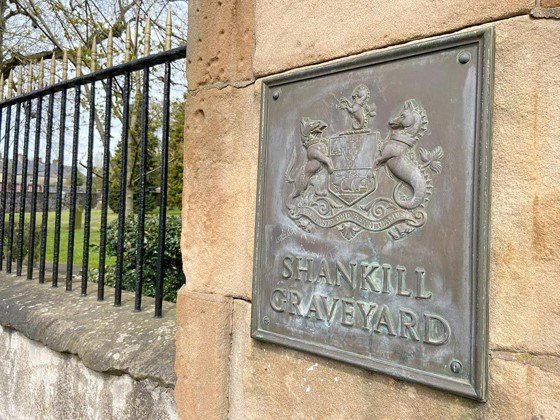Burying Belfast’s Poor
With high rates of disease and mortality, finding somewhere to bury the poor was an ongoing issue in the nineteenth century for all charities and institutions. All of the cemeteries of the town had a poor ground, a very cheap, sometimes free, way of burying the poor.
Here’s a quick guide to the main burial grounds in Belfast in the early 1800s.
Shankill Graveyard, main gate
Shankill
Most burial grounds by the early 19th century were owned by religious denominations. The oldest is likely to be the Shankill burial ground with burials taking place there for centuries before its transfer to Belfast town council in 1776. The oldest burial stone found in the cemetery is dated to 1685, that of George McCauley. The name comes from the Irish “sean cille” meaning “old church”. The medieval church had fallen into decay by the nineteenth century but the increasing demand for space had meant the graveyard had been expanded twice. The current site of the Shankill Cemetery is only a small proportion of what was used as the burial ground with the Shankill and Crumlin Roads being built over sections of the ground.
Although it was used by all denominations and under the remit of the town council, it was generally associated with the Established Church, the Church of Ireland.
‘Plaguey Hill’ in Friar’s Bush graveyard
Friar’s Bush
Friar’s Bush was also based on the site of a medieval church with a legible headstone dating from 1717 but earlier land surveys mark a church and burial ground on the site. During the penal laws, Catholics were not allowed to meet publicly to celebrate mass and gathering at this site was one of the ways Belfast Catholics secretly assembled until the 1760s. The name comes from the hawthorn bush growing in the centre of the graveyard. In the 19th century the ground was expanded and a gate lodge and 8 foot wall were built to enclose it. By this time it had become the primary burial ground for Catholics in Belfast, although other denominations were still buried there too.
Like Shankill, Friar’s Bush had been expanded in 1828 and its poor ground used for victims of the cholera pandemic of 1832. It gained the name ‘Plaguey Hill’. This area was reopened during the famine years to deal with the high mortality levels, but could not hold any more by the middle of the century. Dr Andrew Malcolm wrote in 1852 that it “is excessively overcrowded and were it not far removed from the town, would certainly prove injurious to the public health of its immediate vicinity”.
Marker for the Poor Ground in Clifton Street Cemetery, known as the New Burying Ground in the early 19th century
The New Burying Ground
The Belfast Charitable Society had opened a civic new burying ground in 1797 with a poor ground established in 1799. This cemetery was to provide a new burial site for the town and also raise funds for the Society through selling the expensive wall plots. An Act of Parliament in 1800 formally banned further burials in Belfast’s High Street burial ground, a site which had already been built over, which in turn put more pressure on the long-established cemeteries in Friar’s Bush and Shankill, Catholic and Protestant respectively. Increased pressure on burial space led to the extension of the Clifton Street cemetery in 1828. The poor ground became the primary location for the burial of the poor who died in various charitable institutions, including the Lying-In Hospital, Fever Hospital, District Lunatic Asylum and the Poorhouse itself.
The poor ground of Clifton Street was called into use during times of epidemic disease, so much so that the area became known as the ‘Cholera Ground’ and following the repeated outbreaks of the 1830s, in 1840 it was proposed that the ground be closed to more burials. However, the events of 1847 reversed that decision and once again the poor ground was opened to deal with the excess mortality in the town. It is estimated that around 7,000 people were buried in this area. A stone boulder now marks the spot with the inscription “In this ground lie the remains of several thousand poor. They all had names.”
“Choked up with corpses”
By the early 1840s Belfast’s citizens were aware that they were rapidly running out of room to bury their dead. In May 1842, the Mayor Thomas Verner wrote to the MP W.A. Mackinnon, commenting on the problem:
““I would however observe that the burial-grounds in the neighbourhood are totally insufficient for the mortality that must necessarily occur in a town such as Belfast.””
However, no progress was made.
The stark conditions and increasing mortality rates of the famine years highlighted once again that Belfast was running out of burial space. A meeting of inhabitants was called in July 1847 - the worst year of the famine with skyrocketing cases of ‘famine fever’(most likely typhus) and the middle classes of the town were increasingly worried about where to bury all the poor. The Roman Catholic Right Revd Dr Denvir told the meeting how the existing grounds of Shankill, Friar’s Bush and the New Burying Ground were “choked up with corpses”.
Dr S.S. Thomson reminded the meeting that
““the health of the town was closely connected with having a proper burying place for interring the dead.””
So how did the citizens of Belfast deal with this problem?
The next post will look at how bad the situation truly was in the late 1840s when it came to burying Belfast’s poor.


